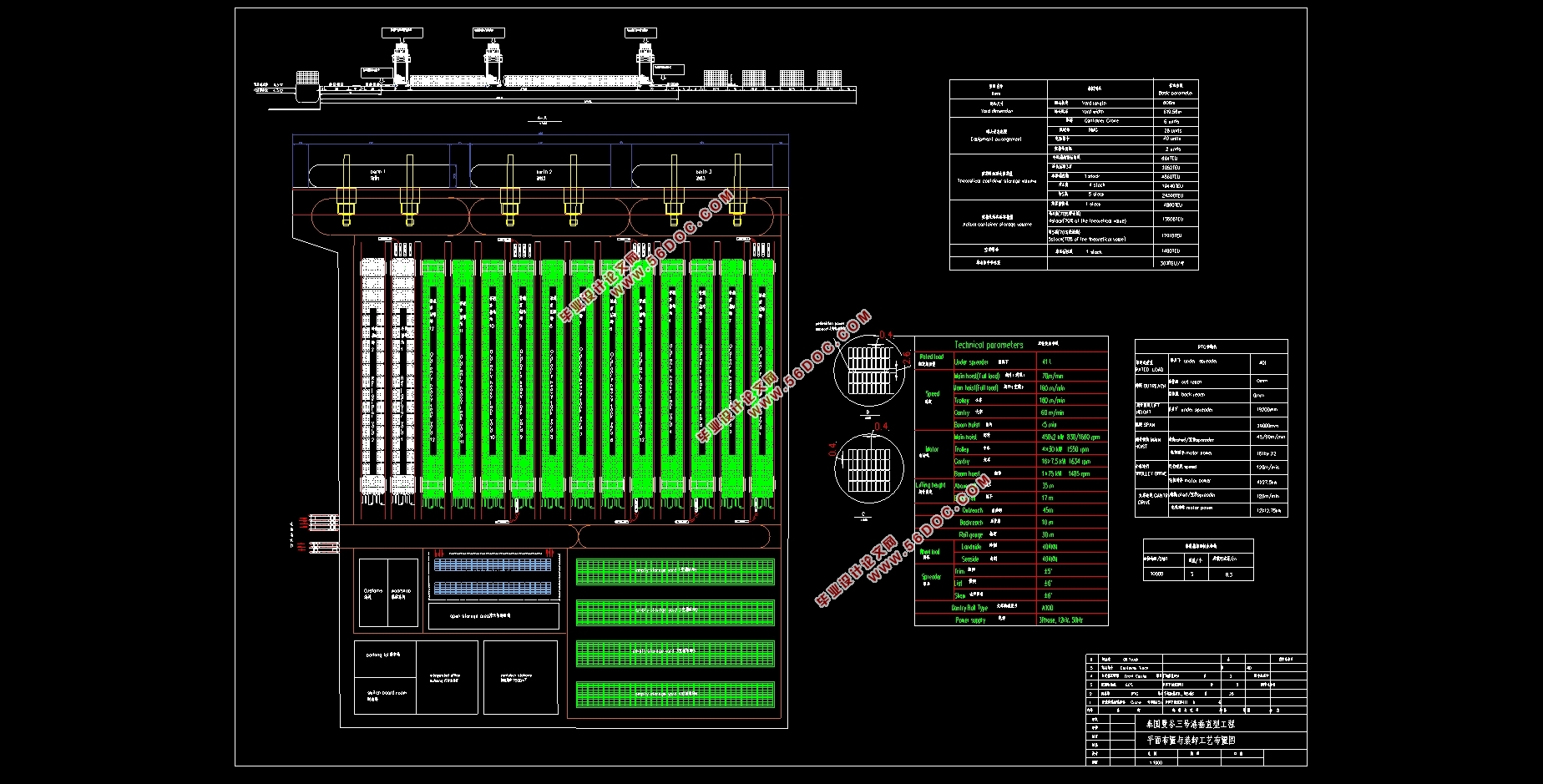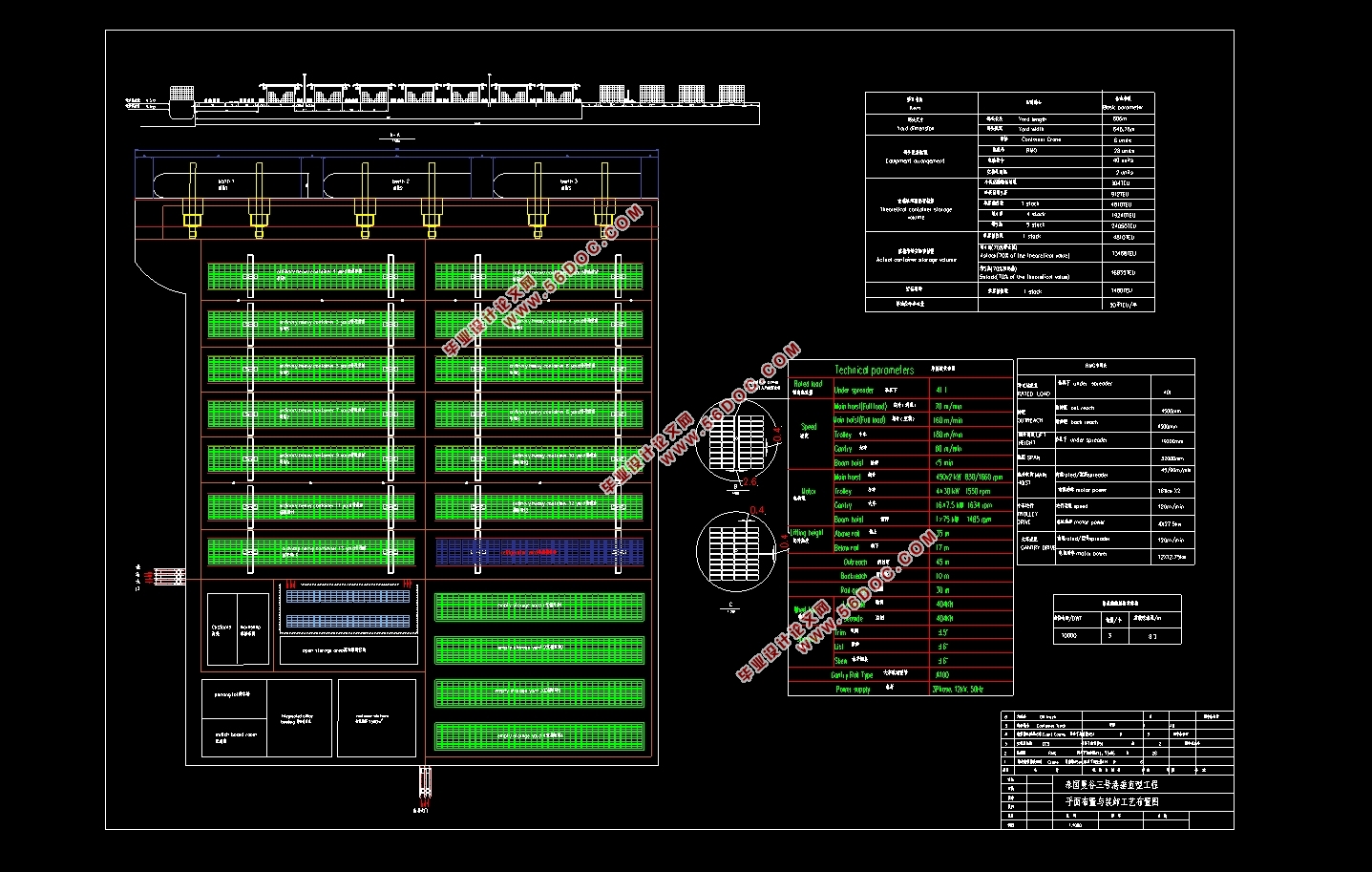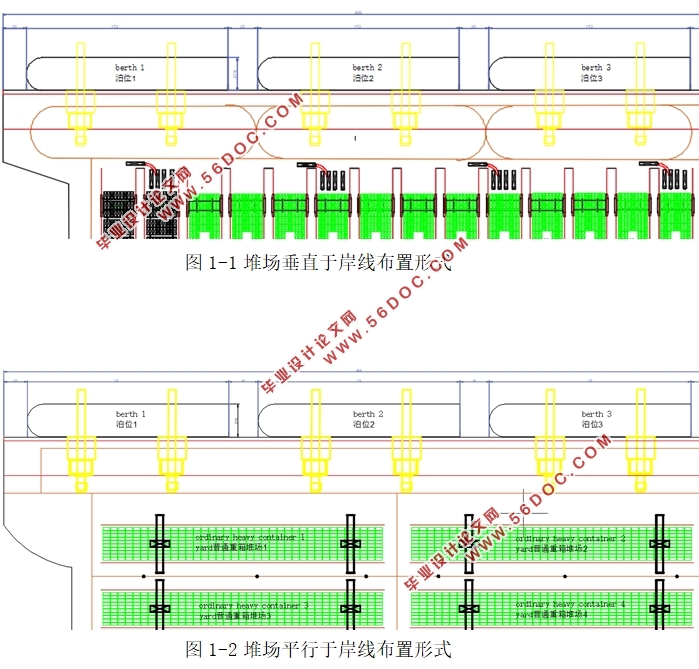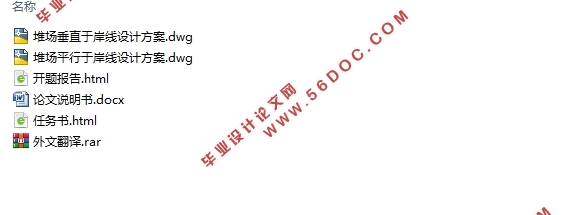泰国曼谷港三号集装箱码头平面布置与工艺设计(含CAD图)(任务书,开题报告,外文翻译,论文说明书30000字,CAD图纸2张)
摘要
走入二十一世纪之后,全球每一个国家经济的前行,全球的进出口的市场储量持续的增大。这对每个国家的集装箱航运产业产生了面对新时代的挑战,迫使其集装箱吞吐量不断增加。伴随着中国“一带一路”战略的发布,东南岸沿海岸国家的海运贸易量得到了一个长足的飞跃。泰国作为东南亚国家中重要的贸易站点,在曼谷港的泊位存在着堆场能力不足,作业设备老化,对船舶适应性不好等诸多问题,已经很难满足对当前集装箱作业量的要求,因此泰国曼谷港三号集装箱码头的设计建设便也提上了日程。
本文旨在为泰国曼谷港三号集装箱码头设计出两种平面布局方案。两种方案以其堆场相对岸线的排布方向加以分别,分别是堆场平行于岸线方案与堆场平行于岸线方案。工作内容包含:在划定的岸线长度和纵深下,进行堆场平行岸线方案与堆场垂直与岸线方案的总平面方案布置和装卸工艺的设计,同时完成码头机械设备的选型和配置。本文的主体设计思路可分为五个方面,即两种平面布置方案的设计分析,码头装卸工艺的设计分析,机械设备的选型和配置,两种平面设计方案的分析对比推荐和经济性分析。第一部分总平面布置部分的核心内容包括码头前沿的总体设计和作业地带的布置,前方堆场和后方堆场的布置。码头大门和生产、生活辅助建筑物的布置;第二部分包括装卸方案的设计计算;第三部分包括港口工作设备的选型和配置,其中包括码头集装箱岸桥、堆场轨道吊、堆场轮胎吊、集装箱正面吊、空箱堆高机和集中水平运输机械的集中选型和配置;第四部分主要包括两种不同的堆场排列方案的优劣对比和推荐;第五部分中经济性分析的主要内容是两种堆场设计方案的金融方面的指标,即投资与回报估算。
通过几个方面的综合比较和查证,在满足泰国曼谷港三号集装箱码头的规模要求的前提之下,根据相关部门推荐的平面工程规划方案,按照最少投资、最大产出为原则,具有优秀可发展性。技术可行性、经济合理性为选择重点,结合世界上的多种港口平面布局方案和曼谷港三号集装箱码头的各种条件,确定了堆场垂直于岸线方案作为推荐方案。
关键词:平面布置;码头设备;集装箱码头;装卸工艺,岸桥;设计
Abstract
Since the beginning of the 21st century, the world economy has taken off, the world's import and export market capacity has been expanding, which has brought challenges to each country's container shipping industry in the face of a new era, forcing its container throughput to increase. With the release of China's "One Belt And One Road" strategy, the maritime trade volume of countries along the southeast coast has got a great leap forward. As an important trade site in southeast Asian countries, Thailand in Bangkok port berth there yard ability is insufficient, equipment aging, bad adaptability of the ship and so on many issues, has been difficult to meet the demands of the current container production, so the design of port container terminal no. 3 in Bangkok, Thailand construction is also on the agenda.
This paper aims to design two layout plans for the no.3 container terminal of Bangkok port, Thailand. The two schemes are distinguished by the arrangement direction of the yard relative to the shoreline, that is, the scheme of the yard parallel to the shoreline and the scheme of the yard parallel to the shoreline. The work content includes: under the defined shoreline length and depth, the layout of the parallel shoreline scheme of the yard and the general plan of the vertical and shoreline scheme of the yard as well as the design of loading and unloading process, as well as the selection and configuration of wharf machinery and equipment. The main design idea of this paper can be divided into five aspects, namely the design and analysis of two kinds of plane layout scheme, the design and analysis of wharf loading and unloading technology, the selection and configuration of mechanical equipment, the analysis, comparison and recommendation of two kinds of plane design scheme and the economic analysis. The core of the first part of the general layout includes the overall design of the wharf front and the layout of the working area, the layout of the front yard and the rear yard. Layout of wharf gate and auxiliary buildings for production and life; The second part includes the design calculation of loading and unloading plan; The third part includes the selection and configuration of port working equipment, including container quayside bridge, yard track crane, yard tire crane, container front crane, empty container stacker and centralized horizontal transport machinery. The fourth part mainly includes the comparison and recommendation of two different schemes. In the fifth part, the main content of economic analysis is the financial index of two kinds of yard design schemes, namely investment and return estimation.
Through comprehensive comparison and verification in several aspects, under the premise of meeting the size requirements of the no.3 container terminal of Bangkok port, Thailand, according to the plane project planning scheme recommended by relevant departments, according to the principle of minimum investment and maximum output, it has excellent developability. Taking the technical feasibility and economic rationality as the key points, combining the various port layout schemes in the world and various conditions of the no.3 container terminal in Bangkok port, the scheme that the storage yard is perpendicular to the shoreline is determined as the recommended scheme.
Keywords: plane layout; Terminal equipment; Container terminal; Handling technology, quayside bridge; design




目录
摘要 I
Abstract I
第1章绪论 1
1.1背景和价值 1
1.2集装箱码头发展 2
1.2.1集装箱码头发展趋势 2
1.2.2集装箱码头发展现状 3
1.3港口装载方式和平面布置前行现状 3
1.3.1港口平面布置发展现状 3
1.3.2港口装卸工艺发展现状 5
1.4规划内容 6
第2章泰国曼谷三号码头装卸工艺总体设计 9
2.1装载方式规划的基础参数 9
2.1.1码头作业天数分析 9
2.1.2设计船型分析 9
2.1.3 主要设计参数 9
2.2装载方式规划运算 10
2.2.1泊位通过能力计算 10
2.2.2堆场容积运算 12
2.2.3拆装箱库储量运算 13
2.2.4集装箱码头大门所需车道运算 14
2.3装载方式方案两种规划 15
2.3.1装卸桥——轨道式龙门起重机装卸工艺方案设计 15
2.3.2装载桥——轮胎式龙门起重机装载方式方案规划 17
2.4本章小结 19
第3章集装箱码头平面布置规划 20
3.1码头前沿地带规划 20
3.1.1码头前沿岸线长度运算 20
3.1.2码头前沿作业地带布置 20
3.2堆场布置 22
3.2.1堆场布置准则 22
3.2.1堆场分块设计(堆场平行岸线方案) 23
3.2.2重箱堆场和冷藏箱堆场布置(堆场平行岸线方案) 23
3.2.3堆场分块设计(堆场垂直岸线方案) 25
3.2.4重箱堆场和冷藏箱堆场布置(堆场垂直岸线方案) 25
3.2.5空箱堆场与危险品箱堆场布置 27
3.3集装箱码头大门规划布置 28
3.3.1集装箱码头大门规划布置准则 28
3.3.2集装箱码头大门规划布置形式 28
3.4制造、生活辅助建筑物布置 30
3.5本章小结 31
第4章集装箱码头机器设备选型及配置 32
4.1集装箱岸桥选型及配置 32
4.1.1集装箱岸桥选型总结 32
4.1.2集装箱岸桥配置分析 36
4.2轮胎式集装箱龙门起重机选型及配置 37
4.2.1轮胎式集装箱龙门起重机选型分析 37
4.2.2轮胎式集装箱龙门起重机配置分析 38
4.3轨道式集装箱龙门起重机选型及配置 39
4.3.1轨道式集装箱龙门起重机选型分析 39
4.3.2轨道式集装箱龙门起重机配置分析 41
4.4集装箱正面吊运机选型及配置 42
4.5空箱堆高机选型及配置 44
4.6水平运输机械选型及配置 44
4.7本章小结 45
第5章岸边集装箱起重机总体设计 46
5.1轮压及其稳定性计算 46
5.2工作循环 51
5.3电机功率 53
5.4本章小结 54
第6章集装箱码头装卸工艺与平面方案确定 55
6.1装卸工艺和平面布置方案拟定 55
6.2 方案比较和推荐方案确定 58
6.3本章小结 59
第7章经济性分析 60
7.1编制依据及原则 61
7.2投资估算 61
7.2.1基础数据 62
7.2.2经济效益分析 62
7.2.3财务效益分析 62
7.3社会影响分析 64
7.4本章小结 64
第8章全文总结 65
参考文献 66
附录一 67
附录二 67
附录三 67
致谢 67
|









